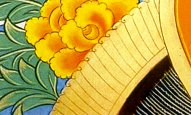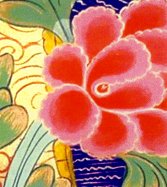| Contents
83.2 Kuei Yang sect 83.3 Lin Chi sect 83.4 Tsao Tung sect 83.5 Yun Men sect 83.6 Fa Yen sect 83.1 Development of Chan sect after Sixth Patriarch After the Sixth Patriarch. the Chan sect spread out into two main branches headed by:
Huai Jang's successor was the great Chan master Ma Tsu [馬祖], who transmitted the Dharma to Pai Chang [百丈], whose disciples were Kuei Shan [溈山] and Huang Po [黃檗]. Kuei Shan and his disciple Yang Shan [仰山] founded the Kuei Yang sect [溈仰宗], i.e. Ikyo Zen in Japanese. Huang Po was succeeded by Lin Chi [臨濟], the founder of Lin Chi sect [臨濟宗], i.e. Rinzai Zen in Japanese. Hsing Sze transmitted Dharma to Shih Tou [石頭], whose successors Yo Shan [藥山] and Tao Wu [道悟] hand it down to Yun Yen [雲巖] and Lung Tan [龍潭] respectively. Yun Yen was succeeded by Tung Shan [洞山], who founded Tsao Tung sect [曹洞宗], i.e. Soto Zen in Japanese, with his disciple Tsao Shan [曹山]. Lung Tan transmitted the Dharma to Te Shan [鐵山], who was succeeded by Hsueh Feng [雪峰]. Hsueh Feng handed it down to Yun Men [雲門], who founded the Yun Men sect [雲門宗], i.e. Ummon Zen in Japanese. Hsueh Feng also handed it down to Hsuan Sha [玄沙], who further transmitted it to Lo Han [羅漢]. Lo Han's successor Fa Yen [法眼] founded another Chan sect called Fa Yen sect [法眼宗], i.e. Hozen Zen in Japanese. Kuei Shan used to train his disciples in realizing the doctrine of Substance [體] and Function [用]. Substance, or essential body, i.e. Dharmakaya in Buddhist terminology, should be all-embracing in order to realize Universal Enlightenment, the 51st stage of Bodhisattva development, while Function should also be universal for realizing Wonderful Enlightenment, the 52nd stage of Bodhisattva development into Buddhahood. When Yang Shan asked about the abode of the real Buddha, his master Kuei Shan replies, "Turn inwards the subtleness of your thoughtless thinking to think of spiritual brightness until your thinking is exhausted, then return it to its source where the fundamental nature and its formal expressions eternally abide, where principle [理] and activity [事] are not in dualism and where is the suchness of the real Buddha." Lin Chi was noted for giving shouts, so as to stop the followers from clinging to any thought and any things in the realm of illusions, and to wake them up to see one's own inner potentiality, i.e. self-nature. This sect also urges the followers to distinguish clearly between 'host' and 'guest' in order to avoid confusion in their meditation. According to his Dharma, relations between 'Host' and 'Guest' are classified into four positions:
As a result, the practitioners can be clear about the absolute Self and the relative illusive phenomena. In order to make the Dharma clearer, Tung Shan and Tsao Shan classified the progressive stages of self-cultivation into five positions, in the analogy of Prince and Minister as follows:
In practice, these five progressive positions are Shift, Submission, Achievement, Collective Achievement and Absolute Achievement. The Yun Men Dharma is not easily understood by most of beginners, as it is rather for those of superior roots. It is noted for its one word answer and seemingly offensive words, so as to wipe out the disciples' prejudices and hesitations when differentiating the immutable Self and the ever-changing illusive phenomena. Fa Yen sect urges all disciples to realize the identity of One Mind, which creates the Three Worlds, i.e. Desire, Form and Formless, and all phenomena are but the product of consciousness. This is the state where the fundamental nature and its formal expressions eternally abide, where principle and activity are not in dualism, and where the suchness of the real Buddha, as taught by the Kuei Yang sect. |




